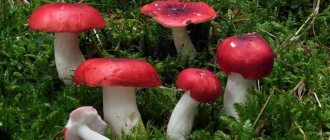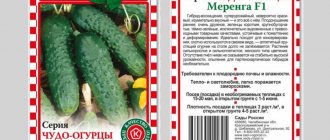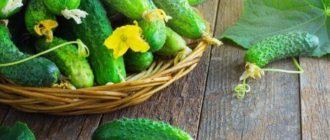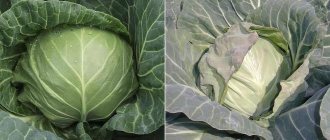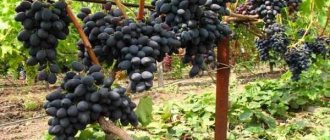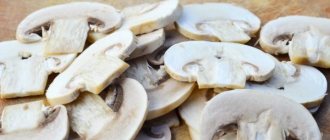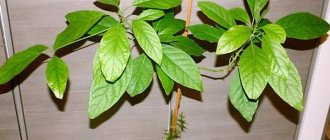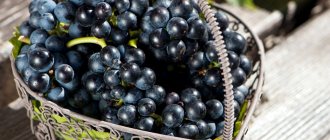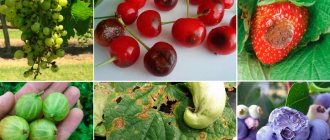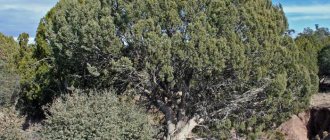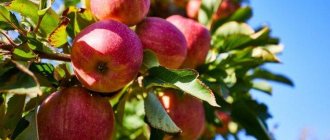Thladiantha dubia, or red cucumber, is an almost unknown plant for Russian gardeners; it can only be found among amateur gardeners as an exotic ornamental plant for vertical gardening, although its fruits are a very unusual delicacy.
This amazing plant comes from the southern regions of the Far East and northeastern regions of China. Tladianta is a perennial ornamental vine from the pumpkin family, so to speak, the Asian cousin of the so familiar zucchini and cucumber.
In natural habitats, Tladiantha dubica is found in coastal meadows, among shrubs, on loose sandy sediments of sea coasts, and also as a common weed in gardens and vegetable gardens.
Its shoots with fluffy hairs reach a length of up to 5 meters; if there is support, it easily rises up due to its antennae and grows quickly. The light green leaves of tladiant are heart-shaped, soft like felt, and have a small fluff on the outside.
Thladiantha dubia
The flowering period is very long, throughout the summer and even until early autumn. This culture is dioecious. Male tladiant plants have bright yellow flowers, similar to tulips with petals bent back. The diameter of the flower is 2-3 cm, collected in inflorescences in the form of brushes. The flowers of female plants look much more modest, flat in shape, not so bright and grow solitary.
With intensive pollination, the plant bears fruit abundantly. Tladianta fruits resemble small cucumbers in color, shape and size, which, as they ripen, turn from green to red or orange-red with barely noticeable stripes. Inside the fruit there is reddish pulp with a large number of hard seeds.
Thladiantha dubia | Thladiantha dubia |
The underground part of tladianta consists of chains of rather large tubers: up to 8 cm long and up to 2 cm in diameter. This Asian woman is unusually prolific, so that in 2-3 years she becomes the full owner of the entire plot, when planting it must be limited on all sides, for example, with slate sheets dug into the ground to a depth of 0.5 m.
Description of the plant
If your soil is poor and even weeds do not grow on it, this is an ideal place for Tladianta. It does not care about the type of soil or its nutrient content. The most valuable thing for her is watering and hilling to ventilate the root system. This will be enough to fill a 2x2 square in 3-4 months.
Choosing a landing site
When choosing a place to plant a plant, it is important to understand that the tubers located underground produce new young shoots that actively climb. To prevent the vines from “spreading” in width, one simple technique is used: the planting is fenced around the perimeter with slate or boards, which are dug 20-30 cm into the ground. This will be quite enough for the tubers to remain within the fence and not occupy new territories.
Male and female vines are grown in different areas, but as a decoration this is not of fundamental importance. Tladianta loves and will curl even where it would seem there is nowhere to curl. When installing the support, you can give the vine the desired shape, and by pinching the tops, you can give it volume.
For better germination, Tladianta is propagated using seedlings. To do this, add existing seeds to the prepared soil mixture, moisten the soil, and cover the container with a plastic bag. After the first shoots appear (and this usually happens on the 10th day), the plastic bag is removed and the plant is placed in the warmest and well-lit place.
After 2-3 true leaves appear (like a real cucumber), tladianta can be planted in open ground. The plant tolerates any frost well, so there is no need to worry about possible losses of the future harvest. However, according to experts, the best temperature for seedlings is 15°C - 18°C.
After the seedlings take root, tubers will gradually form underground. New pagons grow from them, which curl quite quickly.
Tladianta seedlings
Seeds for seedlings are sown in early March-April. Seedlings are transplanted into open ground closer to May. After the tladiantha has fruited and when night frosts occur, the above-ground part can be safely removed using pruning shears. The tubers remaining in the ground are additionally mulched, after which, with the appearance of the first spring rays and the melting of the snow cover, abundant greenery from the vines will appear on the site.
Many gardeners who want to try to grow an unusual vegetable forget that the plant of the pumpkin family is considered a weed and may well choke the growth of other plants located in the neighborhood. Therefore, it is important to consider the time of planting vegetable crops located in close proximity to tladianta.
Seedlings are planted in the same way as cucumber seedlings. Reproduction is also practiced using tubers. To do this, using a sharp shovel, the mother tuber and its shoots are separated, after which the latter are suitable for planting in open ground.
Tladianta propagation is practiced using tubers.
A small hole is made in the soil, at the bottom of which it is recommended to place several teaspoons of superphosphate and peat mixture. Place the tuber or seedling, sprinkle with soil and pour plenty of warm water. After a certain time, the irrigation procedure is repeated.
In order for the plantings to take root as much as possible, it is recommended to plant them in cloudy weather, when there is no heat. The best time is the first ten days of May. After planting, the bed should be shaded with branches or covering material.
There is no difference between special care and usual care for Tladianta. This unpretentious plant feels great without frequent irrigation and hilling. But to get the desired result you will have to comply with the following conditions:
- Irrigation - watering should be frequent and abundant. It is recommended to water daily in hot and dry weather and every other day in spring and early autumn.
- Fertilizer application - potassium and phosphorus increase the percentage of ovaries on female flowers, and calcium and magnesium help the fruits acquire the desired taste. The first spring fertilizing is carried out with organic fertilizers, after which it is limited to mineral ones.
- Pruning - to prevent the vine from growing too much, its lower branches that spread along the ground must be removed using pruning shears. If there is a need to reduce the height of the vine, remove its top and side straps.
If the plant is poorly rooted or has overwintered, then it is necessary to use growth stimulants in early spring. They will help normalize metabolic processes and force the plant to abundantly increase green mass.
The specific taste of the plant itself and the fruits repels many insects, so pests practically do not affect the vine. In rare cases, when humidity increases, fungal infections may occur. They are easily stopped by spraying with Bordeaux mixture.
It's no secret that vegetables can taste anything, but they're certainly not sickly sweet. However, there is one exception to the rule - tladianta (red cucumber). Although it is exotic, it is still a vegetable, with tasty sweet pulp. Tladianta fruits really look like cucumbers, but only red in color and with seeds inside, like a watermelon.
But with its long lashes, the bush looks more like a pumpkin, of which it is a relative. Moreover, if you dig it up, you can harvest the tubers, like potatoes - this is the root system, it is inedible. This is such an interesting plant. Which vegetable does tladianta have the most in common with: potatoes, pumpkin or cucumber? Today we will tell you what this plant really is and how to grow it in your garden.
Tladianta is native to the Far East, where it was previously grown as an ornamental crop. The bush really looks very beautiful when bright yellow inflorescences bloom against the background of emerald foliage. It retains its decorative effect even during the period of ripening of the original red fruits.
Tladianta is a perennial plant and belongs to the pumpkin family. She has a lot in common with him. First of all, these are climbing stems that grow up to 6 m in length over the season. The liana weaves well along the support. This is basically how it is grown: on arches, near old trees or buildings that need to be covered.
The only thing is that its pubescent shoots are stronger than those of a pumpkin. The leaves of the vine are more like squash. They are the same round, on a thick petiole, but smaller. And Tladianta blooms all summer long with beautiful, rich yellow, bell-shaped flowers, like all pumpkin flowers. But that's where their similarities end.
Being a perennial, the liana has a pronounced dormant period. During the winter, its vines die off completely, and only the root system in the form of tubers remains to overwinter in the soil. They are similar to our potatoes. But the fruits, which ripen by mid-autumn, look more like small red cucumbers. Due to this, tladianta is known as the “red cucumber”. The length of the cucumbers does not exceed 6 cm with a diameter of only 2 cm. At first they are green and shaggy, and after full ripening they turn red and the fluff disappears.
Unlike the hard and crunchy cucumber, the flesh of tladianta is juicy and slightly reminiscent of cotton wool in its structure. It is sweet, but the taste cannot be described in one word. It's a cross between kiwi, mango and pineapple. Interestingly, the seeds are almost the same as those of a watermelon: oblong, hard, black.
The perennial “cucumber” vine can rightfully be considered one of the most unpretentious crops. Not only does it feel good in both sun and partial shade. Tladianta is also extremely tenacious and has a high ability to self-reproduce. Almost all the seeds that fall to the ground germinate, and every year it forms more and more baby nodules. Thus, in just a couple of years, the liana significantly expands its possessions, spreading across the site.
Choosing a landing site
As already mentioned, the vine can grow in both sunny and shaded areas. The length of the lashes does not depend on this, but the flowering itself in the sun will be more abundant. It would be correct to plant the tladianta near some kind of support, given its ability to weave. It doesn't have to be an arch. Thanks to the pubescence of the stems and foliage, the vine fits well on the walls of buildings, gazebos, fences and trees.
This could be the far corner of the garden or a place along the fence. And so that the vine does not “go for a walk” throughout the entire site, it is better to limit its place of residence by digging slate at least 50 cm deep.
How to plant
In our climate, tladianta most often reproduces with the help of tubers, and less often with seeds. This is due to the fact that it is extremely difficult to obtain seeds at home without making efforts. Both male and female flowers bloom on the bush at the same time. In order for the fruit to set, the ornamental cucumber must be pollinated. If you help and carry out pollination artificially, then the vine will delight you with a harvest and a large supply of seed material.
By pollinating flowers with pollen from another crop from the pumpkin family, you can get an interesting result. The fruits change their shape, color and taste, but, as a rule, they are always seedless. Therefore, in order to get seeds, it is necessary to pollinate the ornamental cucumber using only its own flowers.
When planting in groups, enough space should be left between the red cucumber bushes. The liana grows well not only upward, but also branches to the sides. In addition, the root system is actively growing new tubers. Next spring they can germinate even at a distance of up to 2 m from the mother bush.
When to plant
One of the very original and unique plants on your site can be Tladianta, a representative of the Pumpkin family. The people have a simpler name - “red cucumber”, since it has similar external features with their favorite vegetable, although the color scheme is clearly different.
Tladiants consider the Far East and China to be their homeland. Despite this, the popularity of such an original culture is justified in different parts of the world, including Europe, the USA and Asia.
Like the classic cucumber, tladianta is a vine plant. The main difference is the horse system, because in a red cucumber it consists of tubers, and not small ones, because the average diameter can vary from 2 to 8 cm. Experts note that the tubers serve as a kind of storage organ, from where the plant receives its main energy.
It is noteworthy that Tladianta is not the only one with underground tubers, since right on the surface of the earth one can also clearly see tubers, but not of large sizes. It is the tubers that become the source of the formation of new young shoots on the site. The main advantage of having tubers in this plant is the fearlessness of not only light frosts, but also full winter frosts.
Tladianta is a liana, so its structure is characteristic of a similar type. Shoots - sets on which tendrils are clearly developed, which are real fasteners for any structures and supports. Remember, in order to contemplate the flowering and fruiting of a red cucumber, you should take care of vertical growth, because otherwise flowering is impossible. There is a central shoot, which is densely “strewn” with foliage. The average length, if support is required, is 5 meters.
The leaf mass of Tladianta is not small, because an indicator of 10 cm is normal. The foliage is located on both sides of the shoots. The color scheme is very beautiful, as the green color has a beautiful light shade. The shape resembles a heart. It is noteworthy that the plate itself is single, solid. Towards the top you can clearly see the sharp tip, but along the edges there are clearly small jagged edges.
Flowering is very abundant, both female and male inflorescences are formed. The color is yellow, sometimes green is added to yellow, creating a tandem. The diameter of the flowers is up to 3-4 cm. They are shaped like umbrellas, slightly racemose. The shape can also be compared to a whisk or bell.
There are 5 petals that are tightly folded, touching each other. Female flowers are not as saturated in color as male flowers. Future fruits begin their formation directly at the base of the flower. The culmination of the plant is considered to be a period of exuberant flowering, which occurs throughout the summer, up to and including September.
Fruiting is indeed very similar to classic cucumbers, since the shape is also elongated, like that of your favorite greens. Another thing is size and color. Initially, the cucumber is green, then as the growing season begins to turn into orange, fiery, and only then red. Red stripes may also be present on the surface - this is normal.
The fruits appear in July, but become ripe no earlier than September. How to determine the degree of maturity of tladianta? The fruits should not only be red, but also quite soft, with a clearly perceptible sweetness. There are seeds inside, and in huge quantities, since each fruit can contain up to a hundred of them. Each seed has a dense coating of a fairly dark color.
Connoisseurs of exotics were clearly wondering whether it was possible to grow Tladianta on their own property. The answer is simple - yes! This plant is absolutely not picky, as it can grow in any area and with any soil composition. The only thing is the presence of sun, maximum partial shade - this is a good place to plant such a plant.
The site needs to be prepared in advance - properly dug up in the fall and fertilized with organic matter. This is ideal. Already in the spring, before planting, the territory should be roughly divided equally, where “female” and “male” tubers should be planted separately. The optimal planting pattern is to maintain a distance of up to 8 cm between tubers.
Be prepared for the fact that already at the end of spring the shoots will actively begin their growth and vegetation, and flowering will begin in June. The growth rate of shoots is impressive. It is noteworthy that the flowering of the “floors” occurs at different periods. So, male inflorescences start at the beginning of summer, but female inflorescences start later - in July.
Harm and contraindications
Naturally, many consumers are concerned about the presence of contraindications and possible harm when using this product, which is still not unusual for many.
Indeed, everyone is accustomed to green cucumbers and knows about the existing precautions. But red cucumbers are still considered exotic. Therefore, today they include the following number of contraindications:
- individual intolerance to vegetable components;
- the presence of diabetes mellitus (for such people a significant restriction is recommended due to the large amount of sugars in the pulp).
General information about culture
The liana, which quickly occupies the entire free territory, perfectly disguises the ruins of buildings or an unattractive exterior. Propagated by seeds and tubers. The latter are located in the ground at a depth of 10-15 cm.
As the vine grows, tladiantha produces male and female flowers. It is recommended to plant the plants separately, which will lead to more abundant flowering. Female flowers are pollinated by a special genus of wild bees.
The fruits eaten are orange-red in color, which form juicy pulp when ripe. Jams, jams, jellies are prepared from tladiant fruits, and are also consumed fresh.
Tladianta dubious, otherwise – red cucumber
Tladiantha is differentiated into male and female plants. Only the latter bear fruit. The fruits are shaped like regular cucumbers. They reach 6 cm in length and do not exceed 2 cm in diameter. They are distinguished by their characteristic red color. The pulp of ripe fruits acquires a dark orange hue.
The plant is perennial. In autumn, the upper part dies off, and tubers, which are similar to potatoes, remain for wintering.
The crop belongs to the pumpkin family, and its fruits are edible. Herbal, not yet ripe cucumbers can be pickled and canned, while ripe ones, orange or red, are eaten fresh.
The fruits fully ripen in September-October. But this fruit is not for everyone. For this reason, it is not worth planting tladianta in large quantities; it still cannot replace everyone’s favorite and familiar cucumbers.
In addition, it is necessary to carefully approach the issue of planting. Since this culture grows very strongly within 2-3 years, and then it is difficult to get rid of it. So that you don't have any problems with it. carefully read all the nuances of planting this plant.
The culture is completely undemanding. Care characteristics include systematic watering on dry days. If the soil is poor, then a little organic fertilizer is added to the water. Tladianta tolerates adverse weather conditions very well. In central Russia, diseases and pests practically do not affect the plant.
To promote growth, fertilizing is carried out throughout the entire growing season:
- Before flowering begins, phosphorus fertilizers are used - they are needed for active development, as well as the development of tubers and fruits. They are applied directly to the root zone. Phosphorus increases the culture's resistance to disease and bad factors.
- During the development of fruits, the crop will require organic matter - manure or compost. Saturates the soil with beneficial microorganisms, which process elements into compounds that are easily soluble and easily absorbed by plants.
Harvesting
Harvesting begins as the fruits form. Depending on the wishes of the gardener, they are picked green or red. In the first year of propagation from seeds, the yield will be low: the plant spends a lot of energy on forming new tubers. The green part of the tladianta dies in the fall, and in the spring new shoots appear in its place.
It is safer to carry out pruning in a timely manner and remove residues from the area. Tubers of the plant are dug up for the purpose of propagation or clearing the site. Some of them should be removed to prevent thickening of the plantings. Storage of seed material is carried out in the basement or any other cool place.
Tladiant is widely used in Eastern medicine. A decoction of seeds, for example, is used as a choleretic or diuretic, and with systematic consumption of natural vegetables, the functioning of the gastrointestinal tract can be restored.
Likewise, the plant has immunostimulating and anti-inflammatory properties and is used to relieve headaches and hypertension. Eastern healers prepare an infusion from the flowers of red cucumber and use it during a flu epidemic. Red cucumber has received such widespread use in medicine due to its high content of vitamins A, B, E, C, macro- and microelements: potassium, calcium, magnesium, cobalt, iron, phosphorus and others.
Tladiantha Doubtful grows in natural conditions in coastal areas, among bushes and coastal meadows. It is classified as a member of the Pumpkin family, a group of herbaceous vines.
Application and beneficial properties
Middle Eastern countries use red cucumber in the treatment of a number of diseases associated with pathologically reduced immunity. Tladianta decoctions have the following beneficial properties:
- They saturate the body with micro and macroelements, which are extremely necessary in everyday life, but do not enter the body with food.
- They accelerate metabolic processes, which has a beneficial effect on weight.
- Control and normalize the functioning of the digestive tract. Red cucumber is an excellent astringent used for frequent digestive disorders.
- They have a pronounced anti-inflammatory effect, which is used in the treatment of gastrointestinal diseases and diseases of the genitourinary system.
- Stabilizes blood pressure.
- Helps get rid of tension headaches and prolonged migraines.
For medicinal purposes, not only the pulp of the fruit is used, but also the leaf part, as well as the tubers. Decoctions, alcohol tinctures, and rubs are prepared from them.
Tladianta fruits
Landing technology
In what conditions do red cucumbers grow best? Planting and care are carried out in accordance with certain rules. First of all, you should choose a place. Tladianta loves the sun, so it will grow well on the south side of the site. Gardeners have noticed that this plant also does well in partial shade.
When breeding this variety of cucumbers, it is important to take into account that the crop tends to grow. During the growing season, shoots with tubers can spread over a distance of up to 2 m. In order to prevent growth throughout the garden plot, it is recommended to fence the tladianta bush, for example, with slate.
Tladianta cannot be called a capricious plant, but you still need to know some of the features of its cultivation. Let's take a closer look at all the stages.
Choosing a place
- Flower growers prefer to plant this vine on the south or south-east side of the site. The plant loves sun and warmth. It is not advisable to plant in places where there is dampness, drafts or north winds.
- Red cucumber grows well in partial shade, under the crown of tall trees, under the roofs of buildings.
- When planting, immediately install a root limiter, since during the summer season the plant can grow several meters to the sides.
Tladianta grows on different soils, even poor ones. But it is preferable to plant on loose and light soil. It is important that the required amount of oxygen and moisture reaches the root system.
The liana grows especially well on loams. It is recommended to regularly moisten the soil, especially in hot and dry weather.
Landing
Where does the red cucumber grow?
As I already mentioned, the homeland of Tladianta is Southeast Asia, Northeast China, and the Philippines. But here in Russia there are places where this vegetable grows wild: in the Far East. On the Internet I came across a photo, the author of which asks: we were walking and met such a miracle on the shore, what kind of plant is it? The author lives in Primorsky Krai. Photo taken at the end of October:
Tladianta in natural conditions
The nuances of growing and propagating Tladianta
When it comes to talking about tladiant, a confrontation of two opinions always arises in me - an optimist and a pessimist. Why? I’ll tell you a little about this interesting plant and my experience, and you can draw your own conclusion.
Description
This plant is unusual and quite decorative.
- Its vines are thin, long, branched, often climbing in my garden to the top of an old apple tree to a height of more than 6 meters, where it peacefully coexists with another vine - lemongrass.
- The entire plant is covered with short and soft hairs.
- The leaves are small and heart-shaped, emphatically elegant.
- The flowers resemble cucumbers and are dioecious.
The botanical name of this crop is Tladianta dubious. Indeed, a lot of doubts arise about the need for the plant to be in the garden. But if you manage to tame the tladianta, then its decorative vines will delight you with their uniqueness, decorating your vacation spots in your summer cottage!
Pollination
In its homeland, Tladianta is pollinated by a small bee that spends the night in male flowers that close at night. And in the morning she flies to feed on the nectar of female flowers, carrying pollen and pollinating them. The plant was brought to Russia, but the bee did not want to live. Our insects, bees, bumblebees, flies, etc., not surprisingly, do not pay any attention to tladianta flowers at all, flying past. There remains hope for artificial pollination.
The plant is dioecious, so some have only males, while others have females.
- If you use male Tladianta flowers for pollination, you will get fruits with seeds.
- If you transfer pollen from pumpkin, cucumber, melon (they are also suitable), then the cucumbers will be seedless.
When to plant
- It is better to sow seeds first for seedlings, in March. Since their shell is hard, they need to be stratified for 3 months. Before sowing, the seeds need to be soaked for 6 hours. It is better to plant immediately in separate cups - this is convenient, because the seeds are quite large. Tladianta seedlings can be transplanted into open ground no earlier than May.
- Young nodules can be planted in the spring, when the soil has warmed up and frosts have passed. Depending on the region, this may be late April - early May.
With the establishment of a stable subzero temperature, the above-ground part of the plant dies, and the tubers easily tolerate even severe frosts. In spring, the liana produces new shoots that grow very quickly; in warm sunny weather, daily growth can reach 10-12 cm.
This vine feels quite comfortable in the garden, in the room, and on the loggia. On a balcony or loggia, it is enough to provide her with a large box with fertile soil, and already in the second year of life up to 10 tubers can form.
When breeding, you need to remember that tladianta is a dioecious plant. For this reason, in order to obtain fruits, it is necessary to have both male and female individuals. They differ in the same way as cucumbers:
- The female culture has a tiny ovary under the flower.
- The male has a smooth stalk in this place.
It is safer to immediately purchase a couple of packs of seeds and dig up tubers from a couple of bushes. If the fruits still do not set, then the plant is manually pollinated with other pumpkin crops. However, in this case, you will not be able to get your own seeds.
How to plant
Tladianta is a hostile crop because it crawls very quickly through the garden and destroys other plants. There are certain tricks that make it possible to avoid its increase. The landing site is limited - they dig slate or roofing felt around the perimeter.
Red cucumbers are grown using seeds, which are sold in specialty stores, or tubers. When using the latter method, the plants germinate quite quickly, for this reason no auxiliary measures are taken. Tubers are placed directly in open ground in the spring, at approximately the same time as potatoes are planted. The sowing depth is 8-10 cm. They have a sufficient supply of nutrients, which guarantee the rapid development of shoots.
The agricultural technology for growing seedlings is similar to the cultivation of an ordinary cucumber. In order to hasten the appearance of greening, soak the seeds in warm water. After germination, they are placed in a solution of elements for 12 hours. To do this, dissolve 1-2 fertilizer tablets in 10 liters of water. A good result is obtained by soaking in a solution of sodium humate at the rate of 3 g of the drug per 10 liters of water. Then the seeds are dried and sowing begins.
How to plant:
- It is safer to use high-calorie pots or cups measuring 10 by 10 cm.
- To fill, soil mixtures are used - rotted peat and mullein (diluted in half with water) in a ratio of 4 to 1 or peat and humus (1 to 1).
- The seed sowing depth is 2 cm.
Afterwards, watering is carried out, and the pots are placed at home or in a greenhouse. During the growth process, the soil is additionally moistened as needed. The shoots are placed in the ground in the phase of 3-5 true leaves. The best distance between plantings is 60−70 cm.
Choosing a landing site
Recipes for dishes with tladianta
The most popular way to consume tladianta, which is preferred by residents of China and the Far East, is to eat the fruits raw. But you can also prepare them for the winter, make jams and preserves from them. Despite the similarity of the recipes, the taste of the dishes is unusual for Europeans.
For winter preparations and preparing snacks, the green fruits of the plant are collected, and jams and preserves are made from ripe red “cucumbers.”
Recipes with tladianta:
Pickled fruits
. The middle with hard seeds is removed, the skin is removed with a sharp knife, and the fruits are cut into even pieces. You should not marinate tladianta fruits with pumpkin or zucchini. Bring the water in the pan to a boil, pour the chopped pieces into a colander and blanch for 3-4 minutes. Leave the pieces in a colander to get rid of excess moisture. Cook the marinade by adding cloves, allspice, cinnamon powder, and sugar to boiling water. Before turning off the marinade, pour 6% apple cider vinegar into a boiling container. The jars are sterilized, pieces of tladianta are placed in them, filled with marinade, and set to sterilize for 10-12 minutes. Then screw on the lids and turn the jars over. It is advisable that the workpieces cool slowly. To do this, they are wrapped in a blanket. Amount of ingredients per 1 kg of fruit: 800 g of water for marinade, 1 g of cinnamon, 3 pcs. cloves, 2 pieces of allspice, 2 tablespoons of apple cider vinegar, half a glass of sugar.
Pea cutlets
. An original dish that combines peas with tladianta fruits. Boil peas, half a glass, until mushy, drain the water. While preparing the puree, add a little dried basil, add some salt, and add red pepper. Cut about half a glass of tladianta, after peeling the fuzzy skin and removing the seeds from the center of each fruit. The fruits should be of medium ripeness, that is, not quite green, but not yet soft. Choose “cucumbers” with orange peel. Chop a small red sweet onion. Blend all ingredients in a blender until smooth, add a little flour and pea broth, and form cutlets. They are fried in a frying pan on both sides until golden brown.
Read also: Cucumber Siberian Garland F1: reviews, variety description, photo
Casserole
. The casserole uses ripe red fruits with aromatic soft pulp. A pack of cottage cheese, 200 g, is ground through a sieve to get rid of lumps. Thick semolina porridge is boiled in half a liter of milk. To do this, add 3 tablespoons of semolina to boiling milk and stir constantly so that it does not burn. The porridge is left to cool. Tladianta is peeled, the seeds are removed from the middle and pureed, adding 100 g of sugar and 2-3 g of vanillin. In the bowl of a food processor or blender, mix semolina porridge, cottage cheese, red cucumber puree, 2 eggs, add wheat flour. The dough will be sticky, but it should flow freely. Grease a baking sheet with butter, pour in the dough, and place apple slices on top. Bake at 180°C for 40-45 minutes.
Amber jam
. The fruits are cut into equal pieces, there is no need to chop them too much, this will happen on its own during cooking, sprinkle with sugar and leave to infuse for 40-60 minutes to release the juice. Tladianta is not very juicy, so you should not expect a lot of juice. 1 kg of fruit - 800 g of sugar. Pour a third of a glass of fresh lemon juice into a container with “red cucumber” juice, add another 300-400 g of sugar, put on low heat and leave to cook, stirring occasionally so as not to burn. Steamed dried apricots, 300 g, cut into small pieces, add a boiling mixture of tladianta and sugar, cook for another 20 minutes. Allow to cool completely, cook again, adding a little cinnamon and vanillin, otherwise the jam will turn out beautiful, but somewhat tasteless. The cooking process is repeated several times until the jam completely thickens.
Sweet and sour jam
. Ingredients for jam: 1 kg of prepared tladianta, 1 kg of sugar, 1 large very sweet orange and 1 lemon. Lemon and orange are washed, the zest is grated, the citrus juice is squeezed out, and mixed with the zest. They carry out the same processes as when cooking the previous jam, cover the pieces of chopped fruit with sugar, leave to get the juice, and put to cook on low heat. After the first boil, add citrus juice with zest, add vanillin and cinnamon. After each boil, remove the pan from the heat and allow to cool completely. When the jam has completely thickened, you can put it in jars.
. Dissolve a tablespoon of dry quick yeast in 2/3 cup of milk, add a teaspoon of sugar, and let it brew for 10 minutes. When the yeast begins to foam, pour 2 tablespoons of vegetable oil into the starter, mix and set aside temporarily. Grind egg yolks, 2 pieces, adding a tablespoon of sugar and a teaspoon of salt. When the yolks become pale, they are carefully mixed with the sourdough and the dough is kneaded. Add enough flour so that the kneading is soft, but the dough does not stick to your hands. The dough is left to rise under a towel until it has doubled in size. Pieces of tladianta, prepared in advance as for making jam, are simmered until soft in a frying pan lightly greased with butter. As soon as the pieces become soft, mash them into a puree, add a little vanillin, cinnamon, or maybe ground nutmeg. Mix everything and cool. Roll out the dough into a layer, cut out circles with a saucer, put the filling into them and form pies. Place them on a baking sheet greased with sunflower oil and let them rise. Beat the egg whites, brush each pie, then prick with a fork. Bake at 180°C.
To prepare tladianta for the winter, you can use recipes for pickling cucumbers. When making jam, regardless of the recipe, you must add a handful of vanillin or cinnamon, otherwise the taste will be bland.
Before preparing desserts, ripe tladianta fruits are peeled and hard seeds are removed from the middle.
How does flower pollination occur?
Since red cucumbers are dioecious, female plants must be separated from male plants. Fruiting occurs only with abundant pollination. Unfortunately, this function is performed only by the symbiont bee. When night comes, they hide in the flowers of the male plant. But as soon as the rays of the morning sun begin to peek through, the bees fly to the female buds in order to feast on the nectar. This is how natural flower pollination occurs.
But this type of bee does not live in Russia, so Tladianta often does not bear fruit. However, gardeners have found a solution - artificial pollination. To do this you will need to take a small brush. With its help, pollen is transferred from the flowers of the male plant to the female ones by simple application. This plant can also be pollinated with pollen from other crops, for example, pumpkin, squash and others. The flowering period lasts until frost.
What are the benefits of tladianta dubious?
Despite its plant origin, the plant contains:
- water (up to 85%);
- vegetable proteins;
- fats (but very little of them);
- carbohydrates (mainly sugar, of which there is a lot);
- dietary fiber (fiber);
- necessary enzymes;
- vitamin A (retinol);
- alpha tocopherol (vitamin E);
- essential B vitamins (riboflavin, niacin, thiamine, folic acid);
- vitamin C (antioxidant ascorbic acid);
- mineral components such as iron, phosphorus, calcium, magnesium and cobalt.
Tladianta is a particularly low-calorie food; the calorie content of a red cucumber is only 14 kilocalories per 100 grams of pulp.
The energy percentage of proteins, fats and carbohydrates is 23/6/71%.
Cultivation care
Despite the originality of the culture, care is minimal and does not represent anything unusual. So, you must clearly control growth and proliferation with the help of trimmings, water correctly and systematically loosen the soil.
The soil should always be wet, but without stagnant water - this is the main thing. Be guided by the weather, so the regularity of watering can be 2 or 3 times a week. Remember, each watering must be accompanied by loosening to avoid the formation of a dense crust, which blocks sufficient oxygen from entering the soil.
The feeding process, as such, is not necessary. If you fertilized the soil in sufficient quantities in the fall, this is quite enough. If for objective reasons it was not possible to fertilize the soil, then in the spring you can make up for it with mineral fertilizers. Conclusion, if you fertilize in the fall, use a third of a bucket of humus per square meter of territory.
Spring fertilizer consists of nitroammophoska in the amount of 40 grams per square meter. These types of fertilizers are interchangeable. Using both is not recommended. If you notice that the plant does not look very attractive, then you can fertilize it with ordinary ash, or rather with its infusion. A liter jar of ash should be filled with a bucket of water and allowed to brew for a couple of days, after which you can safely feed the tladianta, enriching it with potassium.
Growing this crop does not cause much trouble. First you need to choose the right place. It is recommended to loosen the soil regularly. It will be necessary to prune the lower shoots during the growing season. This is done to prevent the plant from growing throughout the entire area. Watering cucumbers depends on the climate. As a rule, the soil is moistened 1-3 times every 7 days.
With the arrival of autumn, the upper (ground) part of the tladianta is cut off. You will definitely need to dig up extra tubers, since it is with their help that the plant reproduces.
For those gardeners looking to produce more flowers, they will need to fertilize their soil. For these purposes, a simple mixture of superphosphate and ash is suitable. You can also water the bushes with a special solution. It is done as follows: take one glass of ash and fill it with 2-3 liters of water. The solution must be kept for two days. It is consumed in accordance with the dosage of 5 liters per 1 m2.
Harvesting
For those gardeners looking to produce more flowers, they will need to fertilize their soil. For these purposes, a simple mixture of superphosphate and ash is suitable. You can also water the bushes with a special solution. It is done as follows: take one glass of ash and fill it with 2-3 liters of water. The solution must be kept for two days. It is consumed in accordance with the dosage of 5 liters per 1 m2.
Advantages and disadvantages
The dubious advantages of Tladianta include:
- possibility of use for medicinal purposes;
- excellent taste;
- ease of care;
- attractive appearance.
The main disadvantage is the rapid growth . In a few weeks, the vine covers everything around, displacing other plants from the area around the house. Gardeners spend years fighting aggressive crops and are sometimes unable to cope with the lush greenery.
But there is a way out! To protect other plants, slate is dug into the ground around the perimeter of the red cucumber bed to a depth of 40-50 cm. This will stop the roots from spreading throughout the entire area.
Reproduction of tladianta
Choosing a landing site
Tladiant can be propagated by seeds, but it is much easier - by tubers, which are planted in early spring or autumn to a depth of 6-8 cm. The distance between tubers is 60-70 cm.
At home, this dioecious plant is pollinated by local wild bees, however, our bees, wasps and bumblebees do not pollinate this foreign plant, so cultivating tladianda will require manual pollination. Moreover, not only the male flowers of the plant itself are suitable as a source of pollen, but also pollen from zucchini, cucumber, pumpkin or squash. In this case, a seedless fruit is formed, but with much better taste than when pollinated by its own pollen.
Tladiantha dubica is a wonderful ornamental plant. Its soft leaves, its very lush flowering for our latitudes, and, of course, its unusual fruits look very original.
For decorative purposes, this plant can be used like any other fast-growing vine: for decorating places that need to be hidden; for landscaping a gazebo or veranda, arches or old trees. There is probably no better material for constructing any “green walls”.
Red tladianta cucumber reproduces by tubers that form on the lower shoots. Outwardly, they are very similar to ordinary potatoes. To ensure that the plant does not take over the entire garden plot, unnecessary tubers are dug up in the fall. From the remaining ones, new tladianta bushes sprout in the spring.
Tubers tolerate low temperatures well, so they are left to overwinter in the soil. You can also dig them up and store them in the cellar until spring, wrapped in film. Tubers are planted with the arrival of the first warm weather. Most often, this work is carried out in April. Tubers are planted at a distance of 60-70 cm from each other.
Red cucumbers can also be propagated by seeds. They have a characteristic black color. Round shape, small sizes. Before growing seedlings, seeds must be soaked for 24 hours in cold, settled water. After this, they are transferred to a damp cloth, where they are left to germinate. As soon as the sprouts have appeared, you can plant the seeds in pre-prepared containers.
It is important to note that the seeds can be sown in open ground for the winter. However, during the first year Tladianta will not bear fruit, since the plant spends all its energy on the formation of tubers.
Such a plant can reproduce both by seeds and root tubers by dividing them.
In general, tladianta is characterized by the violent emergence of new shoots from its roots in the form of tubers. They are called stolons and in huge volumes these horizontal long shoots can increase over a large area of land over a season. For this reason, for preventive purposes, it is recommended to limit the planting of such a plant by digging any obstacles, for example, sheets of slate, into the ground to a depth of up to half a meter.
Reproduction features:
- Tubers should be divided in the spring after shoots have appeared and immediately planted in the soil at the planned location.
- The planting distance is approximately 50 centimeters from each other; a depth of 20 centimeters will be sufficient.
- Immediately after planting, the shoots need to cling to something, for this reason the easiest and best thing is to pull the twine, along which your plant will “rise high.”
In its homeland, as we remember, this dioecious plant has a personal “friend” for this purpose - the local wild bee. Our nature did not take care of such a comrade, because neither our bees, nor wasps, much less bumblebees, pollinate on Tladianta.
In other words, cultivation of Tladianda requires hand pollination. It is curious that not only the male flowers of the plant itself, but also pollen from the simplest garden pumpkin plant (the same cucumbers or squash) can be suitable as a source of pollen. By the way, the fruit in this version will simply be without seeds and with better taste for use as food than the fruit obtained “naturally”.
Reviews
The opinions of summer residents on the advisability of growing red cucumbers are divided: some are happy with the annual green hedge, others cannot cope with the wildly growing vine. As practice suggests, everything depends on the correct planting and care of the plant.
Valentina, Dzerzhinsk: “ A friend who has been growing it in her dacha for ten years shared the red cucumber tubers. She taught me how to properly care for the plant. I planted the tubers near the house, my husband dug slate into the ground to a depth of about a meter so that the rhizome would not spread throughout the entire area. Now we have a green wall every year. We grow crops for decoration and don’t bother with pollination.”
Vasily, Kursk: “Two years ago I bought Tladianta tubers that were declared questionable. In the first year, I didn’t know how to deal with these weaving shoots; everything around was overgrown. In the fall, I dug up the entire plot, removed all the tubers and planted them in a new way, making a fence. Now the plant lives in a strictly designated place for it.”
Vadim, Voronezh: “I became interested in growing red cucumbers at the dacha. I really liked how the plant wraps around fences and walls of houses. He planted it strictly according to the rules and dug in slate. They say that pollination requires special bees, but in reality a plant must have male and female flowers. I bought three packs of seeds, grew seedlings, and as a result, in August I harvested a small harvest of red fruits. Their taste is pleasant, sweet, but not for everyone.”
